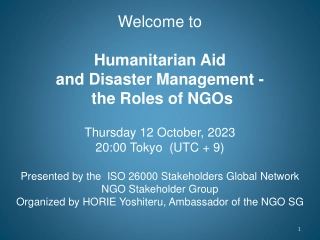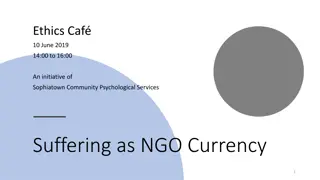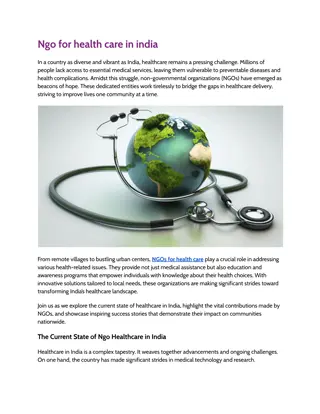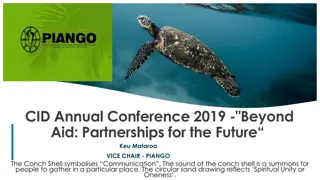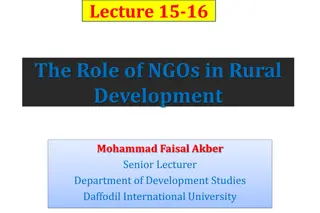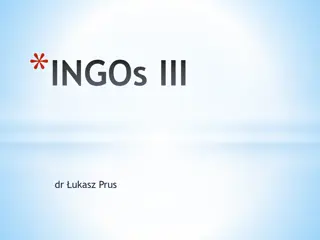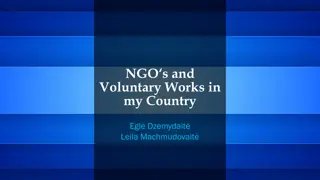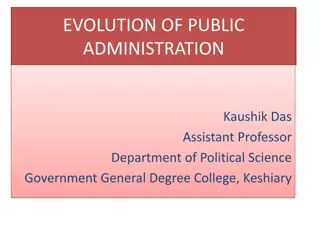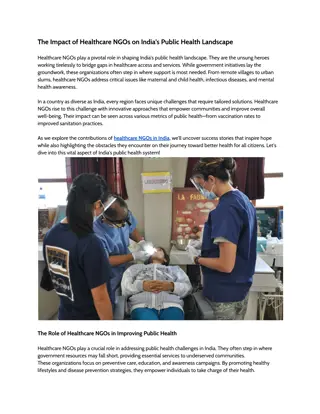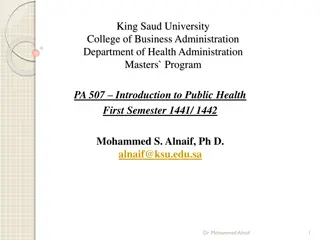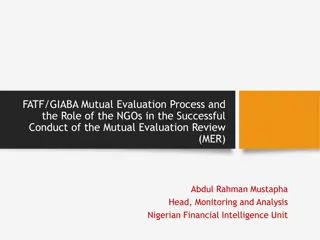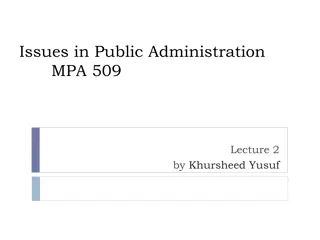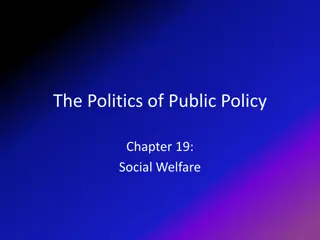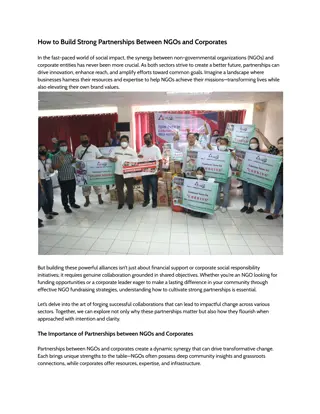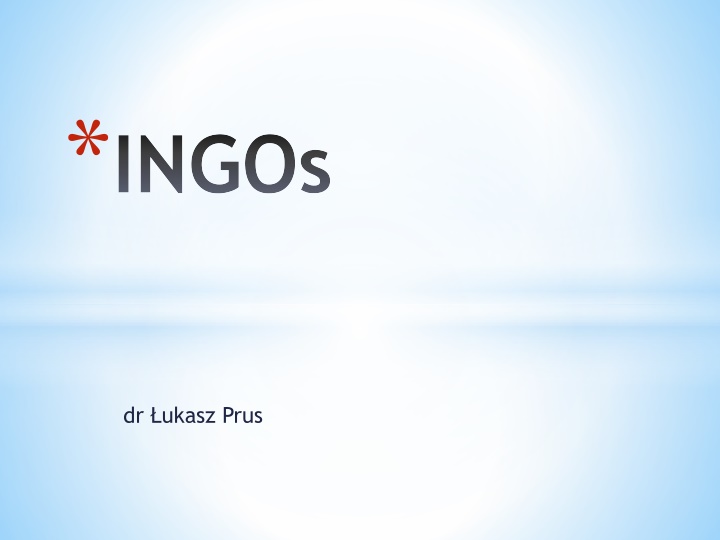
Introduction to INGOs and NGOs in Public Administration
This content provides an overview of International Non-Governmental Organizations (INGOs) and Non-Governmental Organizations (NGOs) in the context of public administration, discussing their definitions, roles, and importance. It highlights the distinctions between INGOs and traditional organizations, their impact on social and humanitarian interventions, and the challenges they face in terms of accountability and definitions.
Download Presentation

Please find below an Image/Link to download the presentation.
The content on the website is provided AS IS for your information and personal use only. It may not be sold, licensed, or shared on other websites without obtaining consent from the author. If you encounter any issues during the download, it is possible that the publisher has removed the file from their server.
You are allowed to download the files provided on this website for personal or commercial use, subject to the condition that they are used lawfully. All files are the property of their respective owners.
The content on the website is provided AS IS for your information and personal use only. It may not be sold, licensed, or shared on other websites without obtaining consent from the author.
E N D
Presentation Transcript
*INGOs dr ukasz Prus
*dr ukasz Prus *Section of Comparative Public Administration *Faculty of Law, Administration and Economics at the University of Wroc aw *lukasz.prus@uwr.edu.pl 2
*Non-Governmental Organizations (NGOs), *Non-profit Organizations (NPOs), *Non-profit sector, *third sector, *voluntary sector, *civil society organizations, *charitable sector, *and social economy *International Non-Governmental Organizations (INGOs) 3
*Definition of INGOs *NGOs was used in the public administration literature *while the term NPOs was used in the political science and international relations literature *NGOs, NPOs, and the third sector synonymously as a kind of simplification in their research of collaboration between business and NGOs in Poland 4
*The term NGO used to define the organizations that neither *related to government *nor traditional for-profit organizations *that support the projects of public interests * and improving the quality of people s lives
*However, the contradictions in defining INGOs are an element of their increasingly importance, *and put them under attacks regarding the accountability
*INGOs are specific type of NGOs that engaged in cross- border social, humanitarian relief and development interventions *such as: *CARE - Cooperative for Assistance and Relief Everywhere 7
*ACTED - Agency for Technical Cooperation and Development *Oxfam - Oxford Committee for Famine Relief *World Vision, *Danish Refugee Counsel (DRC) *Norwegian Refugee Council *Mercy Corps, *and Caritas 8
*Humanitarian action *Three Historical Periods *1) The XIX century until World War I *2) the early XX century through to end the Cold War *3) the last quarter- century 9
*The International Committee of Red Cross and the Protection of War Victims *The inauguration of war- related international humanitarian was in the 1863 with the establishment of the ICRC and the emergence of international humanitarian law. 10
*During the battle of Solferino *the Swiss businessman Henry Dunant witnessed wounded soldiers callously abandoned on the battlefield to die, 12
*Which prompted him to propose the creation of relief societies with trained volunteers to assist injured combatants in times of war. *Within a few years the grassroots campaign produced the ICRC *Dunnat was awarded the first Nobel Prize in 1901 13
*ICRC *International Committee of the Red Cross/ International Red Cross and Red Crescent Movement 16
*The ICRC occupies an unusual position and thus is treated as a separate type of organization *- in a category by itself 18
*Founded in 1863, it is the oldest international humanitarian organization *It is also the largest organization outside of the UN system *A private organization with a board of governors of prominent Swiss citizens, *The ICRC is like NGOs in that receives both private and public contributions, *but governments typically provide 90 % of its annual budget, which in 2012 was about $1.2 billion 19
*It considers itself neither an IGO nor an INGOs because it is the custodian the Geneva Conventions and has a specific recognition in international humanitarian law, for which is the custodian 20
*After The XIX century: *Humanitarianism next great leaps forward ironically but predictably resulted from the two World Wars *In terms of institution-building many familiar NGOs and IGOs emerged in reaction to the forces of destruction unleashed by those cataclysms. 22
*In response to the refugees caused by the Russian Revolution (1917), *The League of Nations established the Highs Commissioner for Russian Refugees *NGOs were running ahead of states in relief, and two sisters, *Eglantyne Jebb and Dorothy Buxton founded Save the Children to handle Russian crisis 23
*Later the Nazi regime led the famous refugee Albert Einstein to found the International Rescue Committee *However, after WW II a new generation of agencies arose to assist victims; *they subsequently developed a global reach, and many still exist 24
*It was the spectre of rampant inhumanity throughout WW II, *not the triumph of humanitarian ideas, that led to hope from a different future. 26
*The Holocaust, *massive displacements, *fire bombings, and *ultimately the use of nuclear weapons *led diplomats and activists to call for protecting civilians. 27
*Growth intergovernmental and nongovernmental machinery continued. *The United Nations Children Fund (UNICEF) *was created in 1946 to provide aid to European children affected by World War II. 28
*In 1953 it became a permanent part of the UN, and the UN General Assembly extended UNICEF s mandate indefinitely *UNICEF has formal agreements with hundreds of NGOs 29
*UNICEF was created on the initiative of dr. Ludwik Rajchman 30
*In 1942 a group of Quakers founded the Oxford Committee of Famine Relief (later shortened to OXFAM) *To respond to the appalling famine in Greece during which perhaps half of the children died. *Shortly after the end of WW II, Lutherans World Relief, Church World Service, and Caritas came into being founded by Lutherans, the US National Council of Churches, and the Vatican, respectively. 33
*The new upheavals that followed in the 1970s and 1980s led in the West to the creation of voluntary organizations by people influenced by the events of the year 1968 *especially student revolts in several countries and the political and cultural ideas they expressed. 34
*Political shift with the thawing and ultimate end of the Cold War opened the last chapter in the history of the international humanitarian system *One of its keys distinguishing characteristics is the dramatic expansion of suppliers in terms of numbers and diversity of organizations 35
*The 2012 global bottom line that approaches $ 18 billion would strike most Masters in Business Administration as a substantial business, especially in light of growth: *a fivefold increase in humanitarian aid (from $800 million in 1989 to some 4.4 billion in 1999) 36
*Moreover, since the terrorist attacks of the 9/11, many countries, especially the US through its counterinsurgency doctrine, *have viewed counterterrorism and humanitarianism as crime- fighting partners, regarding failed states as sanctuaries and staging platforms for terrorists 37
*Humanitarian organizations can become part of winder hearts and minds campaigns, *attempting to convince local populations of the righteousness of armies invading in the name of freedom. 38
*WHO Comes to the Rescue? *Among those that exert influence on the ground from outside a war zone are: *INGOs *The ICRC Red Cross *The UN system *Bilateral aid agencies *External military forces *For-profit firms *And the media 39
*INGOs are often envisioned as the quintessential humanitarian actor and are a crucial source of support for those suffering from wars. *They include such familiar associations as: *CARE Cooperative for Assistance and Relief Everywhere, formerly Cooperative for American Remittances to Europe *Oxfam *Save Children *Doctors of the World *Doctors Without Borders *World Vision *Catholic Relief Services 40
*The delivery of emergency relief is dominated by about fifteen to twenty major INGOs or federations of national NGOs that have annual budgets of at least *$100 million and as large as $ 1 billion and *work in at least eight to ten countries. *Extreme variety, in the size of their operations and their approach to issues, makes generalizations about INGOs problematic *Why? *E.g. *Across-the-boarded characterizations are difficult between giants like CARE and much smaller operations 41
*Nonetheless, it is fair to say that the hallmark of INGOs their link to grassroots and their action orientation. *Many are involved not just in the delivery of succor but also advocacy, legal protection efforts, and attempts at local conflict management. 42
*They are reputed to be more no bureaucratic, flexible, *and creative than their governmental or intergovernmental organizations, *and they certainly are less constrained by legal formalities and diplomatic niceties. 43
*Medecins Sans Frontieres *Doctors Without Borders was founded in 1971 in France by a group of doctors and journalists in the wake of war and famine in Biafra. *The Nigerian Civil War (6 July 1967 15 January 1970). *Small group of French doctors have just returned from working in Biafra and were determined to find a way to respond rapidly and effectively to public health emergencies, without any political, economic and religious influences. 45
*Medecins Sans Frontieres *In southern Nigeria, the province of Biafra had seceded. *This minuscule territory was surrounded by the Nigerian army and the Biafran people were decimated by famine. *The French Red Cross issued an appeal for volunteers 46
*A team of six set off on the ICRC mission to Biafra: *two doctors Max Recamier and Bernard Kouchner * as well as two clinicians *and two nurses. *Being thrown into such a bloody conflict was a real shock for these fledgling doctors, who found themselves having to provide war surgery in hospitals that were regularly targeted by the Nigerian armed forces 47
*French doctor Bernard Kouchner also witnessed events, particularly the huge number of starving children. *He criticised the Red Cross for their seemingly complicit behaviour. *Doctors, led by Kouchner, concluded that a new aid organisation was needed that would ignore political/religious boundaries and prioritise the welfare of victims 48
*Their aim was to establish an independent organisation that focuses on delivering emergency medicine aid quickly and effectively *DWB was created in the belief that all people should have access to healthcare regardless of gender, race, religion, creed or political affiliation, and that people s medical needs outweigh respect for national boundaries 50

